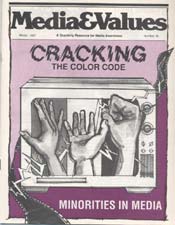CHILDREN:: Vigilant Parents Fill Media's Gaps
|
This article originally appeared in Issue# 38
|
Modem media provide children with much of their primary information about the world. Their potential impact on youngsters' ethnic images is far-reaching. Models of integration, portraits of ethnic characters and information about history and current issues all have the opportunity to provide children with their first ideas and opinions on our racially mixed society.
Children need adult guidance and supervision in forming balanced portraits, however. Because of their limited experience, they are inclined to latch onto stereotypes as they begin to think about the world. Overgeneralizations often appeal to them. If they are presented with stereotyped images, they will buy into them without question.
Because of this, children may need help in interpreting some classic children's programs. They need to know that occasional black-face characters in cartoons or cowboys shooting Indians without a second thought don't represent reality. Even a famous Disney movie like Song of the South distorts the treatment of blacks on plantations, and shows the white plantation owners treating the Uncle Remus character like an irresponsible child.
Although these programs may not have a strong influence on how children behave on a day-to-day basis, they can have a subtle impact on desensitization to injustice and the creation of subconscious attitudes.
Current children's programs, especially Saturday morning cartoons, also create concerns, however, even when they don't appear to have any racially identified characters, Perhaps the most important issue to consider is the tendency to build on stereotypes in general, making these attitudes seem natural. The popular Smurfs, for example, present characters with one personality trait each, and they are named for that trait. The same is true of the Seven Dwarfs. In general, children's programs deal in absolutes, showing characters as either good or bad, smart or stupid, happy or sad. This creates a mindset in children that feeds into racism and sexism.
As usual, the best antidote to these dangers is adult participation. If parents and other concerned adults can screen the media that children experience and watch, and listen or read it with them, they can help to counteract stereotypes and provide needed background. Then they can:
- Comment on negative images of any societal group. Tell the child if they feel the image is unfair.
- Point out that everyone can be smart, stupid, silly, serious, helpful or in need of help at different times. Everyone is capable of good deeds and everyone makes mistakes.
- Use opportunities created by media to educate children about slavery, immigration and civil rights.
- Provide children with positive multiethnic experiences. Firsthand experience is more powerful than any media stereotype.



